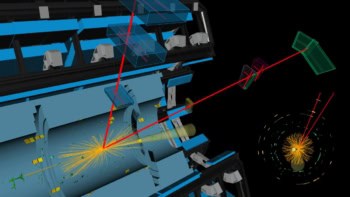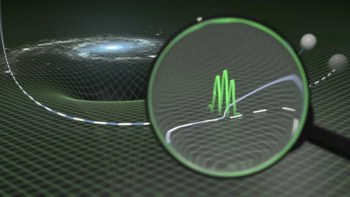
By adapting mathematical techniques used in particle physics, researchers in Germany have developed an approach that could boost our understanding of the gravitational waves that are emitted when black holes collide. Led by Jan Plefka at The Humboldt University of Berlin, the team’s results could prove vital to the success of future gravitational-wave detectors.
Nearly a decade on from the first direct observations of gravitational waves, physicists are hopeful that the next generation of ground- and space-based observatories will soon allow us to study these ripples in space–time with unprecedented precision. But to ensure the success of upcoming projects like the LISA space mission, the increased sensitivity offered by these detectors will need to be accompanied with a deeper theoretical understanding of how gravitational waves are generated through the merging of two black holes.
In particular, they will need to predict more accurately the physical properties of gravitational waves produced by any given colliding pair and account for factors including their respective masses and orbital velocities. For this to happen, physicists will need to develop more precise solutions to the relativistic two-body problem. This problem is a key application of the Einstein field equations, which relate the geometry of space–time to the distribution of matter within it.
No exact solution
“Unlike its Newtonian counterpart, which is solved by Kepler’s Laws, the relativistic two-body problem cannot be solved exactly,” Plefka explains. “There is an ongoing international effort to apply quantum field theory (QFT) – the mathematical language of particle physics – to describe the classical two-body problem.”
In their study, Plefka’s team started from state-of-the-art techniques used in particle physics for modelling the scattering of colliding elementary particles, while accounting for their relativistic properties. When viewed from far away, each black hole can be approximated as a single point which, much like an elementary particle, carries a single mass, charge, and spin.
Taking advantage of this approximation, the researchers modified existing techniques in particle physics to create a framework called worldline quantum field theory (WQFT). “The advantage of WQFT is a clean separation between classical and quantum physics effects, allowing us to precisely target the classical physics effects relevant for the vast distances involved in astrophysical observables,” Plefka describes
Ordinarily, doing calculations with such an approach would involve solving millions of integrals that sum-up every single contribution to the black hole pair’s properties across all possible ways that the interaction between them could occur. To simplify the problem, Plefka’s team used a new algorithm that identified relationships between the integrals. This reduced the problem to just 250 “master integrals”, making the calculation vastly more manageable.
With these master integrals, the team could finally produce expressions for three key physical properties of black hole binaries within WQFT. These includes the changes in momentum during the gravity-mediated scattering of two black holes and the total energy radiated by both bodies over the course of the scattering.
Genuine physical process
Altogether, the team’s WQFT framework produced the most accurate solution to the Einstein field equations ever achieved to date. “In particular, the radiated energy we found contains a new class of mathematical functions known as ‘Calabi–Yau periods’,” Plefka explains. “While these functions are well-known in algebraic geometry and string theory, this marks the first time they have been shown to describe a genuine physical process.”

European Space Agency gives construction go-ahead for LISA gravitational-wave mission
With its unprecedented insights into the structure of the relativistic two-body problem, the team’s approach could now be used to build more precise models of gravitational-wave formation, which could prove invaluable for the next generation of gravitational-wave detectors.
More broadly, however, Plefka predicts that the appearance of Calabi–Yau periods in their calculations could lead to an entirely new class of mathematical functions applicable to many areas beyond gravitational waves.
“We expect these periods to show up in other branches of physics, including collider physics, and the mathematical techniques we employed to calculate the relevant integrals will no doubt also apply there,” he says.
The research is described in Nature.



